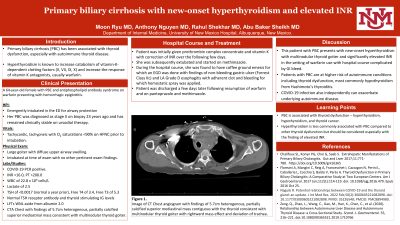Back


Poster Session B - Monday Morning
Category: Biliary/Pancreas
B0062 - A Case of Primary Biliary Cirrhosis With New Onset Hyperthyroidism and Supratherapeutic INR
Monday, October 24, 2022
10:00 AM – 12:00 PM ET
Location: Crown Ballroom

Has Audio

Moon Ryu, MD
University of New Mexico Hospital
Albuquerque, NM
Presenting Author(s)
Moon Ryu, MD, Anthony Nguyen, MD, Rahul Shekhar, MD, Abu Baker Sheikh, MD
University of New Mexico Hospital, Albuquerque, NM
Introduction: Hyperthyroidism is known to increase catabolism of vitamin-K-dependent clotting factors (II, VII, IX, X) and increase the response of vitamin K antagonists, usually warfarin. Primary biliary cirrhosis (PBC) has been associated with thyroid dysfunction (TD), especially with autoimmune thyroid disease. In the below case, a patient with known PBC on warfarin is found to have severely elevated INR related to new-onset hyperthyroidism with clinical consequences of hemorrhage including upper GI bleed.
Case Description/Methods: A 64-year-old female with PBC and antiphospholipid antibody syndrome on warfarin was admitted for hemorrhagic epiglottitis requiring emergency intubation and supratherapeutic INR. Her PBC was diagnosed as stage II on biopsy 23 years ago and has remained clinically stable on ursodiol therapy.
On presentation, the patient was tachycardic, tachypneic, and had O2 saturations < 90% on HFNC prior to intubation. Physical exam significant for larger goiter with diffuse upper airway swelling. She was admitted and found to have COVID-19 infection, INR >16.0 and PT >200.0 (limit of lab), WBC of 22.8, and lactate of 2.5. LFTs WNL aside from albumin of 2.0. TSH was < 0.0017 (limit of lab) and free T4 of 3.4, free T3 of 5.3. TSH receptor antibody (TRAB) and thyroid stimulating immunoglobulin (TSI) levels were normal. Her last TSH was normal a year ago. CTA chest found a 5.7cm heterogeneous, partially calcified superior mediastinal mass consistent with multinodular thyroid goiter.
Patient was initially given prothrombin complex concentrate and vitamin K with correction of INR over the following few days. She was extubated and started on methimazole. During the hospital course, she was found to have coffee ground emesis for which an EGD was done with findings of non-bleeding gastric ulcer (Forrest Class IIc) and LA Grade D esophagitis with adherent clot and bleeding for which hemostatic spray was applied. Patient was discharged a few days later following resumption of warfarin and on pantoprazole and methimazole.
Discussion: The above case demonstrates a rare case of PBC and new-onset hyperthyroidism due to multinodular thyroid goiter causing significantly elevated INR in the setting of warfarin use with hospital course complicated by GI bleed. PBC is associated with TD - hyperthyroidism, hypothyroidism, and thyroid cancer. Hyperthyroidism is less commonly associated with PBC compared to other TDs but should be considered especially with a finding of elevated INR.
Disclosures:
Moon Ryu, MD, Anthony Nguyen, MD, Rahul Shekhar, MD, Abu Baker Sheikh, MD. B0062 - A Case of Primary Biliary Cirrhosis With New Onset Hyperthyroidism and Supratherapeutic INR, ACG 2022 Annual Scientific Meeting Abstracts. Charlotte, NC: American College of Gastroenterology.
University of New Mexico Hospital, Albuquerque, NM
Introduction: Hyperthyroidism is known to increase catabolism of vitamin-K-dependent clotting factors (II, VII, IX, X) and increase the response of vitamin K antagonists, usually warfarin. Primary biliary cirrhosis (PBC) has been associated with thyroid dysfunction (TD), especially with autoimmune thyroid disease. In the below case, a patient with known PBC on warfarin is found to have severely elevated INR related to new-onset hyperthyroidism with clinical consequences of hemorrhage including upper GI bleed.
Case Description/Methods: A 64-year-old female with PBC and antiphospholipid antibody syndrome on warfarin was admitted for hemorrhagic epiglottitis requiring emergency intubation and supratherapeutic INR. Her PBC was diagnosed as stage II on biopsy 23 years ago and has remained clinically stable on ursodiol therapy.
On presentation, the patient was tachycardic, tachypneic, and had O2 saturations < 90% on HFNC prior to intubation. Physical exam significant for larger goiter with diffuse upper airway swelling. She was admitted and found to have COVID-19 infection, INR >16.0 and PT >200.0 (limit of lab), WBC of 22.8, and lactate of 2.5. LFTs WNL aside from albumin of 2.0. TSH was < 0.0017 (limit of lab) and free T4 of 3.4, free T3 of 5.3. TSH receptor antibody (TRAB) and thyroid stimulating immunoglobulin (TSI) levels were normal. Her last TSH was normal a year ago. CTA chest found a 5.7cm heterogeneous, partially calcified superior mediastinal mass consistent with multinodular thyroid goiter.
Patient was initially given prothrombin complex concentrate and vitamin K with correction of INR over the following few days. She was extubated and started on methimazole. During the hospital course, she was found to have coffee ground emesis for which an EGD was done with findings of non-bleeding gastric ulcer (Forrest Class IIc) and LA Grade D esophagitis with adherent clot and bleeding for which hemostatic spray was applied. Patient was discharged a few days later following resumption of warfarin and on pantoprazole and methimazole.
Discussion: The above case demonstrates a rare case of PBC and new-onset hyperthyroidism due to multinodular thyroid goiter causing significantly elevated INR in the setting of warfarin use with hospital course complicated by GI bleed. PBC is associated with TD - hyperthyroidism, hypothyroidism, and thyroid cancer. Hyperthyroidism is less commonly associated with PBC compared to other TDs but should be considered especially with a finding of elevated INR.
Disclosures:
Moon Ryu indicated no relevant financial relationships.
Anthony Nguyen indicated no relevant financial relationships.
Rahul Shekhar indicated no relevant financial relationships.
Abu Baker Sheikh indicated no relevant financial relationships.
Moon Ryu, MD, Anthony Nguyen, MD, Rahul Shekhar, MD, Abu Baker Sheikh, MD. B0062 - A Case of Primary Biliary Cirrhosis With New Onset Hyperthyroidism and Supratherapeutic INR, ACG 2022 Annual Scientific Meeting Abstracts. Charlotte, NC: American College of Gastroenterology.
